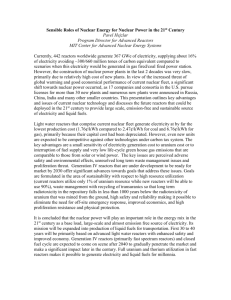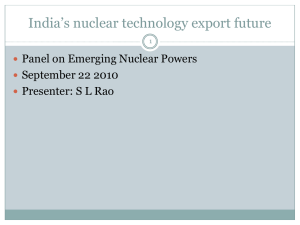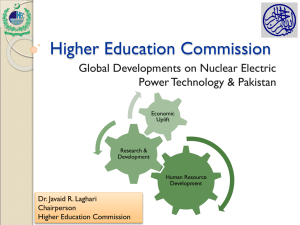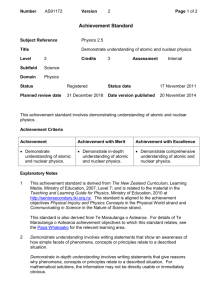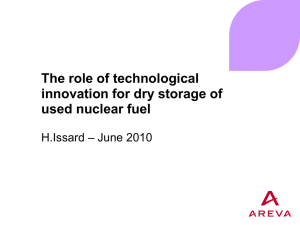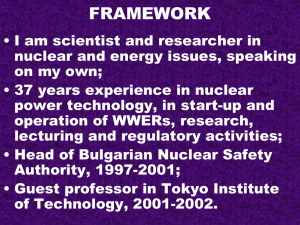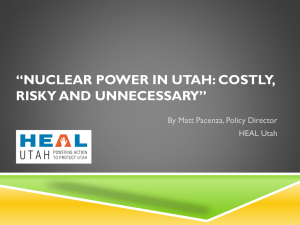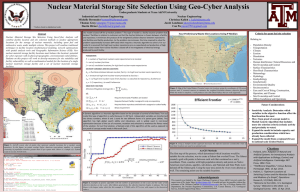Far from “Solving Global Warming,” Atomic Power
advertisement
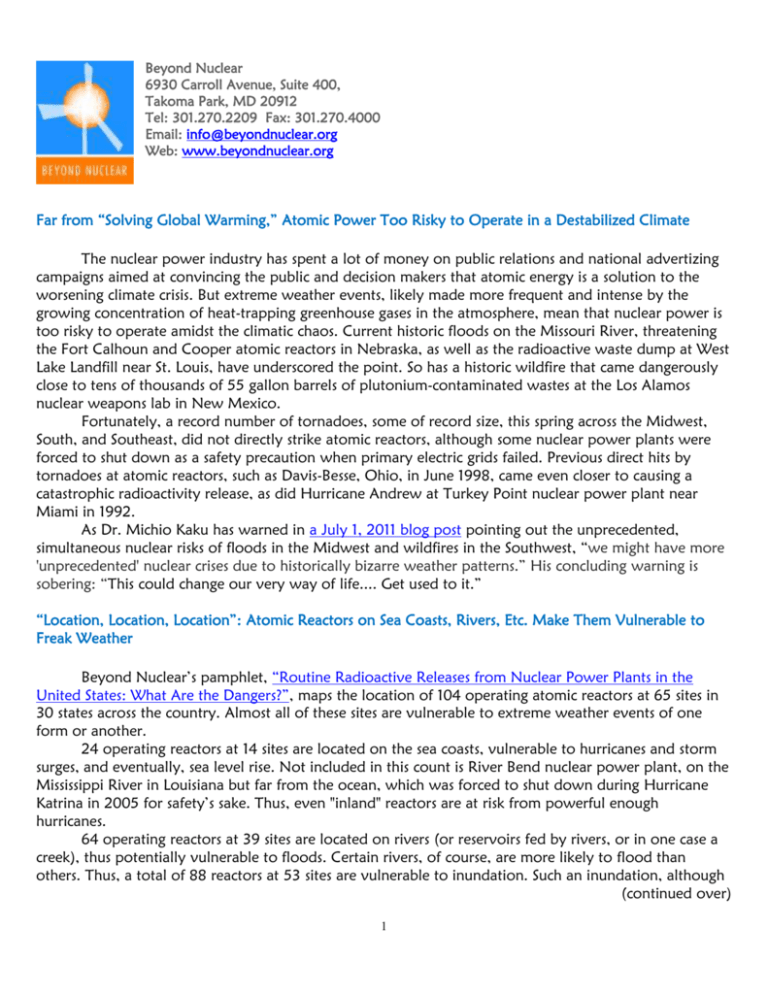
Beyond Nuclear 6930 Carroll Avenue, Suite 400, Takoma Park, MD 20912 Tel: 301.270.2209 Fax: 301.270.4000 Email: info@beyondnuclear.org Web: www.beyondnuclear.org Far from “Solving Global Warming,” Atomic Power Too Risky to Operate in a Destabilized Climate The nuclear power industry has spent a lot of money on public relations and national advertizing campaigns aimed at convincing the public and decision makers that atomic energy is a solution to the worsening climate crisis. But extreme weather events, likely made more frequent and intense by the growing concentration of heat-trapping greenhouse gases in the atmosphere, mean that nuclear power is too risky to operate amidst the climatic chaos. Current historic floods on the Missouri River, threatening the Fort Calhoun and Cooper atomic reactors in Nebraska, as well as the radioactive waste dump at West Lake Landfill near St. Louis, have underscored the point. So has a historic wildfire that came dangerously close to tens of thousands of 55 gallon barrels of plutonium-contaminated wastes at the Los Alamos nuclear weapons lab in New Mexico. Fortunately, a record number of tornadoes, some of record size, this spring across the Midwest, South, and Southeast, did not directly strike atomic reactors, although some nuclear power plants were forced to shut down as a safety precaution when primary electric grids failed. Previous direct hits by tornadoes at atomic reactors, such as Davis-Besse, Ohio, in June 1998, came even closer to causing a catastrophic radioactivity release, as did Hurricane Andrew at Turkey Point nuclear power plant near Miami in 1992. As Dr. Michio Kaku has warned in a July 1, 2011 blog post pointing out the unprecedented, simultaneous nuclear risks of floods in the Midwest and wildfires in the Southwest, “we might have more 'unprecedented' nuclear crises due to historically bizarre weather patterns.” His concluding warning is sobering: “This could change our very way of life.... Get used to it.” “Location, Location, Location”: Atomic Reactors on Sea Coasts, Rivers, Etc. Make Them Vulnerable to Freak Weather Beyond Nuclear’s pamphlet, “Routine Radioactive Releases from Nuclear Power Plants in the United States: What Are the Dangers?”, maps the location of 104 operating atomic reactors at 65 sites in 30 states across the country. Almost all of these sites are vulnerable to extreme weather events of one form or another. 24 operating reactors at 14 sites are located on the sea coasts, vulnerable to hurricanes and storm surges, and eventually, sea level rise. Not included in this count is River Bend nuclear power plant, on the Mississippi River in Louisiana but far from the ocean, which was forced to shut down during Hurricane Katrina in 2005 for safety’s sake. Thus, even "inland" reactors are at risk from powerful enough hurricanes. 64 operating reactors at 39 sites are located on rivers (or reservoirs fed by rivers, or in one case a creek), thus potentially vulnerable to floods. Certain rivers, of course, are more likely to flood than others. Thus, a total of 88 reactors at 53 sites are vulnerable to inundation. Such an inundation, although (continued over) 1 caused by an earthquake-spawned tsunami, led to the ongoing triple reactor meltdown and high-level radioactive waste pool fires at Fukushima Daiichi. (Many U.S. reactors are also at risk of earthquakes, and some, as on the California coast at San Onofre and Diablo Canyon, to tsunamis.) 13 operating reactors at 9 sites are located on the U.S. side of the Great Lakes (an additional 20 reactors are located on the Canada side of the Great Lakes in Ontario). Among other things, these reactors are vulnerable to tornadoes. A tornado damaged the Fermi 2 nuclear power plant in Monroe, Michigan in June, 2010, knocking out the primary electric grid. Fortunately, this happened after it had been discovered, just 4 years earlier, that Fermi 2’s emergency diesel generators had been inoperable for two decades, from 1986 to 2006. Fermi 2 is the largest General Electric Boiling Water Reactor of the Mark 1 design in the world – a replica of Fukushima Daiichi Units 1 to 4, only significantly bigger, and with more high-level radioactive waste in its storage pool than all four failed Japanese units put together. These Great Lakes reactors are located immediately adjacent to the drinking water supply for 40 million people downstream in the U.S., Canada, and numerous Native American/First Nations, comprising a remarkable 20% of the world’s surface fresh water. Too Warm, or Lack of Enough, Cooling Water Supply Could Force Atomic Reactors to Power Down or Shut Down Entirely On the opposite end of the extreme weather spectrum from flooding, warming waters and droughts could force the shutdown of numerous atomic reactors across the U.S. for lack of adequate cooling. The three reactors at Palo Verde, Arizona are so lacking in water to begin with that the plant relies on the sewage of Phoenix, pumped from over 30 miles away, to provide cooling! In the Southeast, host to dozens of operating reactors, rivers and reservoirs have already grown so warm in recent years that, on some summer days, plants have been forced to power down or shutdown entirely, as at the three reactor Browns Ferry complex in Alabama. Even reactors on the Great Lakes have been forced to shut down due to the water being too warm – as at the twin D.C. Cook reactors in southwest Michigan in 2006, as well as at a nuclear power plant on Lake Ontario in upstate New York in the late 1990s. Incredibly, even reactors on the OCEAN have been forced to shut down because the seawater was too warm – as on a bay in Sweden several years ago. The most infamous such episode, however, was in France in 2003 -- during that deadly heat wave, in which tens of thousands (of mostly elderly people) actually perished, French reactors were forced to either power down or shutdown (removing electricity desperately needed for air conditioning), or else were allowed to discharge superheated water to rivers, damaging flora and fauna. Historic droughts and low river levels in the Southeast threaten to deprive reactors of needed cooling water supplies. Several years ago, a reactor in Romania on the Danube River was forced to shut down, when the river level fell beneath the plant’s cooling water intake pipe. Granted, these shut downs may have been short in duration, but this can be expected to grow more common as the planet warms. And when reactors partially power down, or shut down entirely during hot weather, it often happens at time when reliable electricity supplies are needed most. The same could be said of any nuclear power plant shut down due to extreme weather events. Not only are energy efficiency and renewables such as solar power and wind power ever more cost effective than nuclear power, they are also safer and more reliable in a global warming world. Best of all, they are cleaner – representing actual solutions to the climate crisis. To learn more or take action, see Beyond Nuclear’s website at www.beyondnuclear.org. To find links to related information about the risk of climate change to nuclear power, and nuclear power’s inability to help fight the climate crisis, go to http://www.beyondnuclear.org/climate-change/. 2
